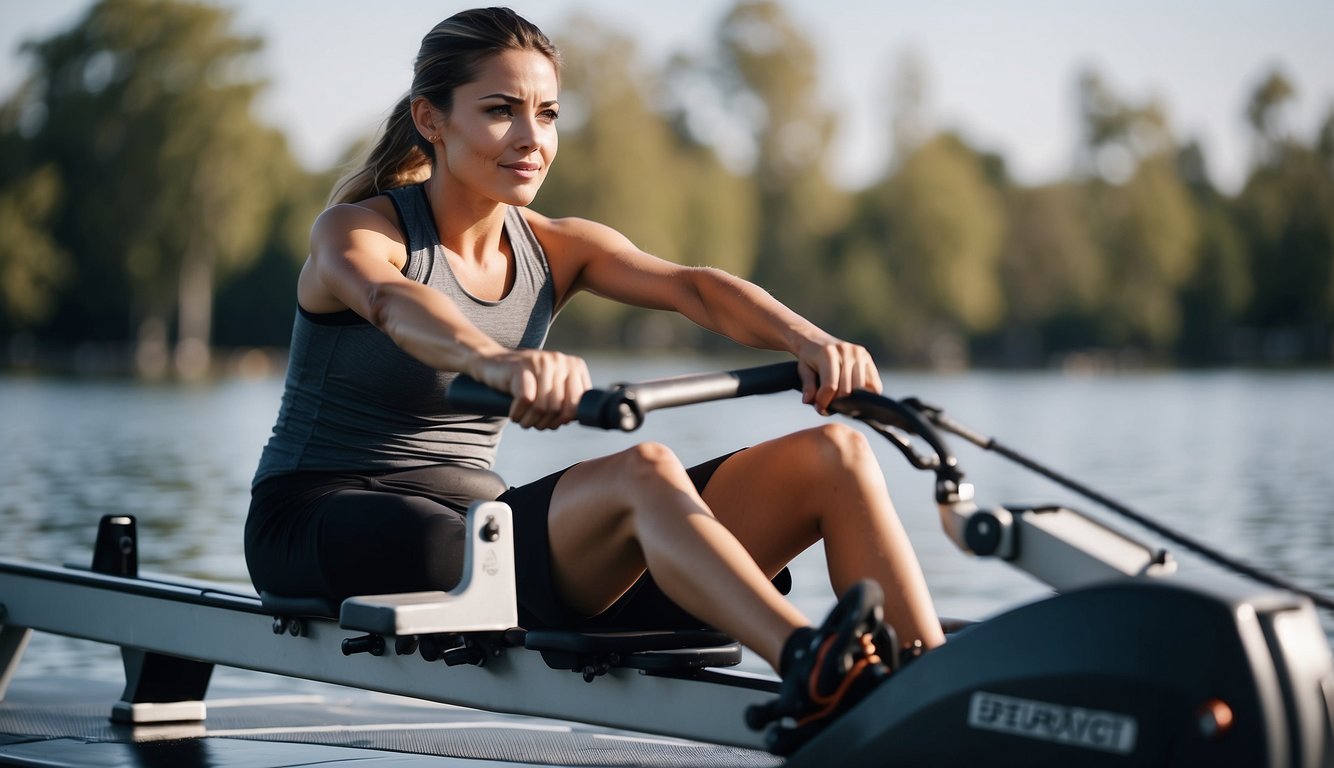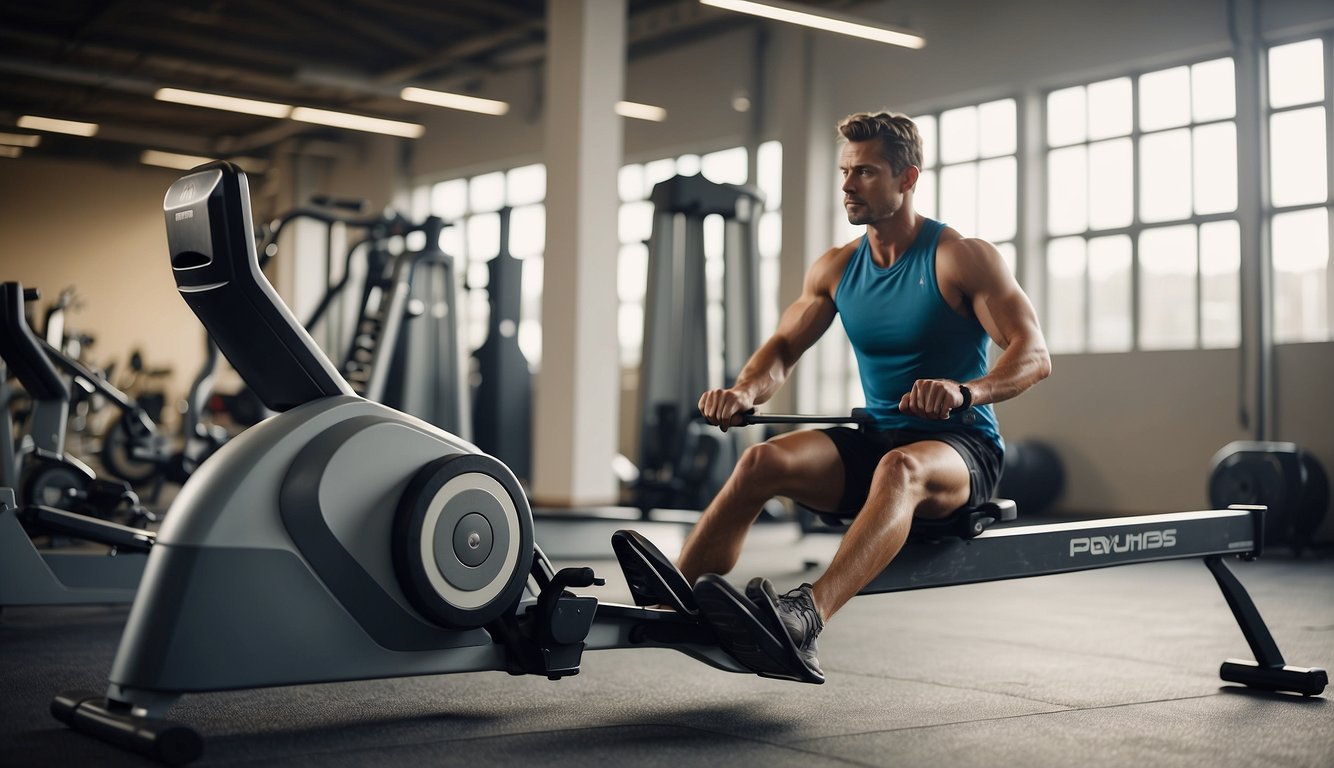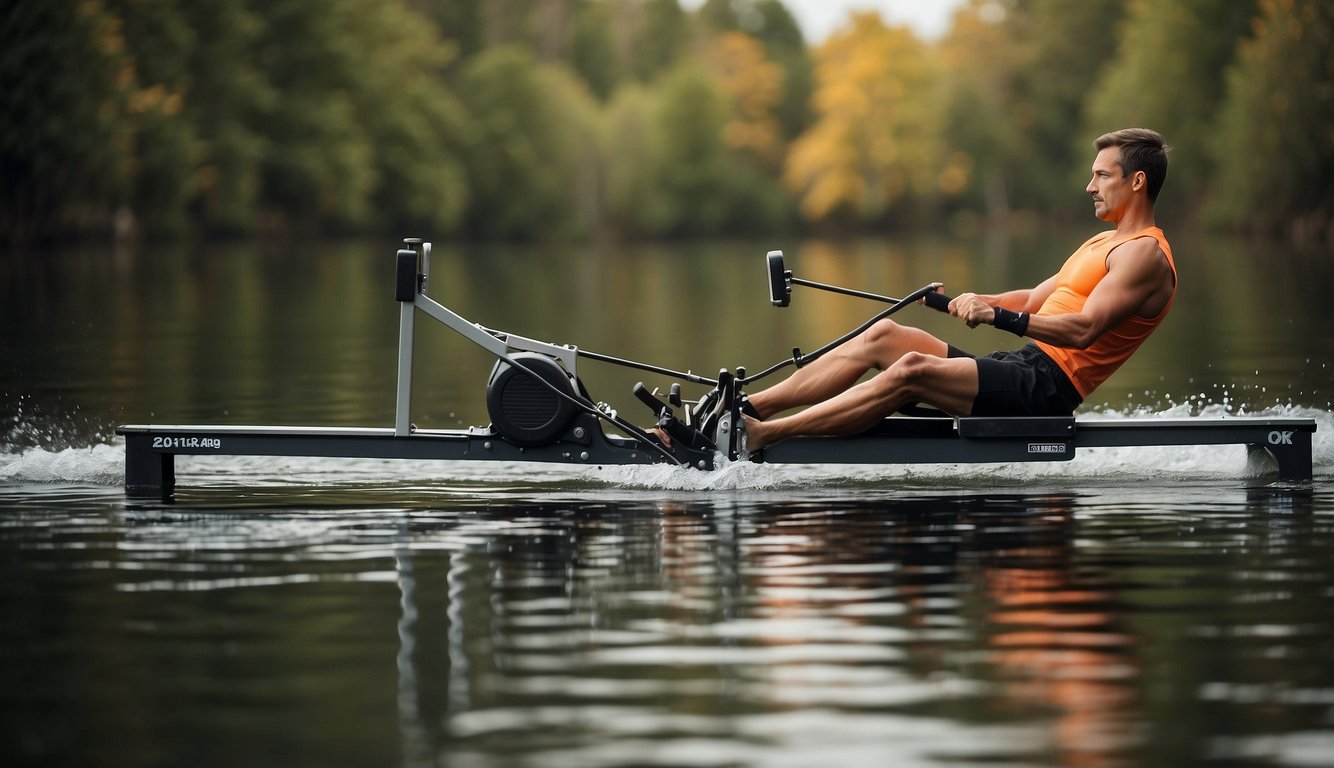Rowing machines offer a comprehensive workout that targets a multitude of muscles, providing both strength training and cardiovascular benefits. They simulate the action of watercraft rowing, translating the physical demands of the motion into an effective fitness activity.
Often favoured for their efficiency, rowing machines engage the legs, core, back, and arms, promoting muscle growth, improving endurance, and boosting cardiovascular health. By pulling against resistance, users can adjust their workouts to suit their individual fitness levels, making rowers suitable for both beginners and seasoned athletes.

The consistent rhythm of rowing movements also benefits the heart. As a low-impact exercise, it minimises stress on the joints while still providing a heart rate increase, comparable to that of other vigorous aerobic activities.
It's an inclusive exercise that can be tailored to any age or fitness level, and the rhythmic nature of rowing combined with resistance can also provide therapeutic mental benefits, aiding in stress reduction and mental clarity.
Key Takeaways
- Rowing machines provide a full-body workout, enhancing strength and cardiovascular health.
- The low-impact nature of rowing is gentle on joints while still offering significant aerobic benefits.
- Rowing is adaptable and beneficial for mental wellness, suitable for a wide range of fitness levels.
Understanding Rowing Machines

In examining rowing machines, it is integral to understand the different types of resistance they offer and their key components. Each aspect defines the machine's functionality and suitability for different fitness levels and training requirements.
Types of Resistance
Flywheel resistance:
- Air resistance machines utilise a flywheel to create a smooth, flowing stroke. The resistance naturally increases as the user pulls harder.
- Magnetic resistance machines provide a quieter and more consistent rowing experience by using magnets moving closer to or further from the flywheel.
- Water resistance rowing machines simulate actual rowing with paddles in a tank of water, creating a realistic resistance that feels like rowing on water.
- Hydraulic resistance relies on cylinders filled with fluid for tension, making these machines more compact and easier to store.
Key Components of a Rowing Machine
Frame and Seat:
- The frame should be sturdy, ensuring it can withstand continuous usage and support the intended weight capacity.
- A comfortable, sliding seat is essential for a long and effective workout.
Footplates and Handle:
- Stable footplates with adjustable straps secure the user's feet during exercise.
- The handle needs to be ergonomically designed to prevent strain on the hands and wrists.
Console/Display:
- A clear display is pivotal for tracking metrics such as distance, time, stroke rate, and calories burnt.
- Some advanced models provide connectivity for fitness tracking and interactive training programs.
Understanding these features allows users to choose a rowing machine that meets their specific fitness goals, whether they're seeking a high-intensity workout or a lower-impact exercise to build endurance.
The Fundamentals of Rowing Technique

Mastering the rowing technique is crucial for maximising the workout's effectiveness and minimising the risk of injury. Proper form is essential across all stages of the rowing stroke to ensure efficiency and safety.
Proper Rowing Technique
Proper rowing technique involves maintaining a strong posture and aligning the body correctly to optimise power and reduce strain. The rower should sit up straight, with shoulders relaxed and the core engaged. Hands must grasp the handle with an even grip, and the wrists should remain flat.
When preparing to row, the shins should be vertical, heels may lift slightly, and the body should lean forward at the hips with arms extended, taking care not to hunch the back.
The Rowing Stroke Phases
The rowing stroke is segmented into four distinct phases: the catch, drive, finish, and recovery. Each part of the stroke requires precision and proper form.
Catch Position:
- The starting pose with shins vertical and shoulders in front of the hips.
- Beginning of the kinetic chain where power starts.
Drive:
- Major phase where legs push off, transferring power through the back and arms.
- Heels press down and the body opens up out of the forward lean.
Finish (Also known as the Release):
- The rower's legs are extended, elbows past the body, handle near the sternum.
- Body leaned back slightly, wrists flat and core braced.
Recovery:
- The handle moves forward past the knees before the knees bend, signalling movement back to the catch position.
- Opportunity for the muscles to prepare for the next stroke.
Each phase must be executed with continuous fluidity to maintain proper form and maximise the benefits of rowing workouts.
Physical Benefits of Rowing Machines
Rowing machines offer a comprehensive workout that targets numerous physical components, notably enhancing cardiovascular fitness and muscle strength.
Rowing Machines for Cardio Endurance
When they engage in rowing, individuals benefit from a significant aerobic exercise that demands sustained effort and increases heart and lung efficiency. Rowing elevates the heart rate, promoting better cardiovascular health. By improving the circulation of blood and the transport of oxygen throughout the body, it also contributes to a stronger blood vessel network.
Rowing for Muscle Strength and Toning
The action of rowing activates a variety of muscle groups across the body, facilitating both muscle strengthening and toning. Key areas targeted include the legs, which account for a major portion of the exertion, as well as the core and arms. Regular use of a rowing machine ensures a balanced workout that covers the back, shoulders, and glutes, leading to improved overall muscular health.
Rowing Machines for Shoulder Strength
Rowing machines offer a comprehensive workout, which includes considerable benefits for the shoulder muscles. By employing the correct technique, individuals can effectively utilise a rowing machine to enhance the strength of their shoulder muscles, comprising the deltoids, rhomboids, and rotator cuff muscles.
Engagement of Shoulder Muscles:
- The Catch: At the beginning of the stroke, shoulders are extended forward, priming the muscles.
- The Drive: As rowers pull the handle toward their torso, their shoulders retract, working the deltoids and rhomboids effectively.
- The Finish: This part involves the posterior deltoids, aiding in completing the stroke with power.
Rowing not only helps in building muscle mass, but it also promotes better shoulder stability and endurance. The repetitive motion aids in conditioning the muscles for endurance. This is beneficial since the shoulders are crucial for a multitude of daily activities and sports.
Key Tips for Maximising Shoulder Strength:
- Maintain a straight back to optimise muscle engagement.
- Use a controlled motion to avoid undue stress on the shoulder joints.
- Focus on power through the drive phase to involve the shoulder muscles fully.
A variety of rowing machine exercises can be performed, each targeting different components of the shoulder muscles. By incorporating rowing into one's workout routine, individuals can experience a noticeable improvement in shoulder strength and functionality.
Rowing Machines and Back Muscles
Rowing machines are acclaimed for their comprehensive workout capabilities, particularly for the back muscles. When utilising a rowing machine, one engages a multitude of muscles in the back, including the latissimus dorsi—essential for shoulder movement—and the rhomboids, which support the shoulder blades.
Key Back Muscles Worked
- Latissimus Dorsi: Large muscles on each side of the back.
- Rhomboids: Between the shoulder blades, critical for retraction.
- Trapezius: Upper back and neck muscles.
It is widely recognised that rowing is beneficial for the lower back, as the motion strengthens the erector spinae muscles which support the vertebrae. This has a stabilising effect, potentially minimising lower back pain. However, it is imperative to maintain proper form to reap these benefits and to prevent injury.
Benefits for the Back
- Strengthens core stability: Critical for preventing back pain.
- Improves posture: By working the muscles that support the spine.
- Eases tension: In the back muscles, potentially alleviating discomfort.
Many might question, "Is rowing machine good for your back?" The answer largely lies in the meticulous observation of technique. Correct posture on a rowing machine includes a straight back, chest out, and core engaged. These elements ensure that the workout enhances back muscular development and health.
Consistency in training and technique can make rowing an effective way to fortify the back muscles, contributing to overall back health and function. Proper engagement of the back muscles during the exercise can make rowing an integral part of a back-strengthening regimen.
Rowing Machines for Weight Loss
Utilising a rowing machine is an effective strategy for individuals aiming to reduce their total body fat percentage. It offers a comprehensive workout that targets multiple muscle groups simultaneously, which can lead to a substantial calorie burn.
During a typical session on a rowing machine, an individual engages both their upper and lower body, which results in a high-energy exercise with the potential to burn calories efficiently. The amount of calories expended depends on various factors, including workout intensity and duration.
| Workout Time | Estimated Calories Burnt |
|---|---|
| 30 minutes | 200-300 calories* |
| 60 minutes | 400-600 calories* |
*Calories burnt will vary depending on individual weight, intensity of exercise, and metabolism.
Rowing workouts increase the heart rate and promote the use of stored fat as fuel, making them a valuable addition to weight loss regimens. They are also scalable in intensity; therefore, suitable for people of varying fitness levels. Moreover, the low-impact nature of rowing limits the stress on joints, which is beneficial for long-term fitness and weight management.
Here are some insights into the effectiveness of rowing machines for weight loss:
- Indoor rowing fosters a high-intensity, full-body workout, optimising fat burn and boosting metabolism (Rowing Machines and Weight Loss: Maximising Fat Burn).
- Rowing engages the leg muscles primarily during the stroke's drive part (Healthline's take on rowing benefits).
- It utilises approximately 86% of the body's muscles, contributing to muscular strength and endurance while promoting fat loss (Fit&Well's rowing plan).
Advantages of Rowing Over Other Forms of Exercise
Rowing machines provide a unique combination of benefits, making them a standout option for fitness enthusiasts. They are particularly known for their low-impact nature and ability to provide a full body engagement during workouts.
Low-Impact Nature
Rowing is considered a low-impact activity, meaning it exerts minimal stress on the joints. This makes it a safer alternative to high-impact exercises like running.
For individuals with joint concerns or those recovering from an injury, a rowing workout offers a way to stay active and improve cardiovascular fitness without the risks associated with repetitive pounding associated with some exercises, like running on a treadmill.
Full Body Engagement
Unlike stationary bikes or ellipticals, a rowing workout demands engagement from both the upper and lower body, resulting in a comprehensive full-body workout. It targets major muscle groups, including the back, legs, arms, and core, providing balanced muscle development and improved overall fitness.
This aspect of rowing workouts also makes them an effective form of cross-training, complementing other forms of exercise by ensuring all muscle groups are activated and trained.
Rowing Machines for Rehabilitation and Recovery
Rowing machines are widely recognised for their role in the rehabilitation process, providing a low-impact, high-benefit exercise option for individuals recovering from various injuries. They are particularly effective for supporting recovery days and aiding those with osteoarthritis, as well as for strengthening knees and elbows without placing undue stress on these joints.
Rowing for Scoliosis
Rowing is an excellent exercise for individuals with scoliosis, as it promotes symmetrical muscular development and spinal alignment. The rhythmic, low-impact movement can help in the management of back pain and aid in strengthening the core muscles, which are crucial for spinal support.
The adjustable resistance levels of rowing machines allow users to customise their workout intensity, making it suitable for rehabilitation phases and catering to the specific needs of their recovery journey.
-
Rehabilitation benefits:
- Improves cardiovascular fitness
- Enhances flexibility
- Low impact on joints
-
Targeted areas:
- Knees: Enhances joint stability
- Elbows: Increases range of motion
Rowing machines play a critical role in the rehabilitation continuum, from the early stages where gentle movement is essential, to later stages where increased resistance is used to rebuild strength. In the context of scoliosis treatment, consistent use of a rowing machine can greatly contribute to overall recovery and long-term back health.
Rowing for Mental Wellness and Stress Reduction
Regular engagement with a rowing machine offers more than just physical fitness; it contributes to mental wellness and can be an effective stress-reducer. Rowing mimics the repetitive movements of water-based rowing, providing a meditative quality as the individual focuses on rhythm and form. This meditative aspect encourages a present state of mind, helping to distract from daily stresses.
The action of rowing stimulates the production of endorphins, the body's natural mood lifters. This release can lead to an elevated mood and a feeling of well-being. It's a natural antidote to stress, enhancing the mind-body connection and promoting mental clarity.
Additionally, consistent aerobic exercise, such as rowing, has been shown to help reduce blood pressure. High blood pressure is often associated with elevated stress levels, so rowing can contribute to cardiovascular health and stress management.
The benefits of rowing extend to various aspects of mental health:
- Endorphin Boost: Engaging in rowing increases endorphin production, which can reduce stress and enhance mood.
- Blood Pressure Regulation: Aerobic activities like rowing help manage blood pressure levels, contributing to overall stress reduction.
- Mind-Body Synchronicity: The rhythmic nature of rowing reinforces the connection between mind and body, fostering mental focus and calmness.
In summary, along with building physical strength and endurance, a rowing machine can be a valuable tool for improving mental health and managing stress.
Integrating Rowing into Fitness Routines
Rowing machines offer a unique blend of cardio and strength training, making them a versatile addition to fitness routines. They can be seamlessly incorporated into various workout styles and are particularly effective for those looking to improve cardiovascular health, endurance, and full-body coordination.
CrossFit and High-Intensity Training
CrossFit enthusiasts find rowing machines incredibly beneficial due to their ability to deliver high-intensity interval training (HIIT). A typical CrossFit workout involving a rowing machine might consist of short bursts of intense rowing to elevate the heart rate, followed by rest periods. These intervals maximise calorie burn and boost cardiovascular fitness.
Example HIIT Rowing Workout:
- Warm-Up: 5 minutes at a moderate pace
- Work Intervals: 30 seconds of full-intensity rowing
- Rest Intervals: 1 minute of light rowing
- Repeat: 8–10 cycles
- Cool Down: 5 minutes of gradually decreasing pace
Creating Balanced Workout Plans
Including rowing in a balanced workout plan enhances flexibility and coordination while providing a challenging cardiovascular workout. Rowing exercises engage the legs, core, arms, and back, demanding coordination and rhythm. By integrating rowing sessions, individuals diversify their fitness regimes, which can lead to improved endurance and muscle tone.
Weekly Rowing Integration:
- Monday: Full-body strength training
- Wednesday: Rowing with interval training
- Friday: Lower intensity, endurance-focused rowing
Incorporating rowing into a weekly fitness routine helps to ensure a comprehensive approach to health and fitness, targeting multiple aspects of physical well-being.
Frequently Asked Questions
Rowing machines are multifaceted exercise equipment that can benefit one's fitness in various ways. They're keenly recognised for promoting weight loss, enhancing cardiovascular health, and offering muscle strengthening benefits to various parts of the body.
Are rowing machines good for weight loss?
Rowing machines provide a robust workout that can lead to weight loss. They engage numerous large muscle groups, which results in significant calorie expenditure and can contribute to a reduction in body fat when used consistently over time.
Are rowing machines good for cardio?
Rowing machines are excellent for cardiovascular health. They elevate the heart rate, improving heart and lung function while increasing endurance. Regular use can enhance one's overall cardiorespiratory fitness.
Are rowing machines good for your back?
When used correctly, rowing machines can strengthen the back muscles. They target the upper and lower back, improving posture and reducing the risk of back pain. However, proper form is crucial to avoid strain or injury.
Are rowing machines good for your shoulders?
Rowing machines can benefit shoulder health by strengthening the muscles around the shoulder joint. However, careful attention should be paid to form to prevent overexertion or stress to the shoulders.
Is a rowing machine good for scoliosis?
For individuals with scoliosis, it's important to consult with a healthcare provider before using a rowing machine. While it can offer back muscle strengthening, the symmetrical rowing motion may need to be modified to accommodate their condition.
How long should I use a rowing machine for?
Time spent on a rowing machine can vary based on fitness levels and goals. Beginners may start with 10-15 minutes, while more experienced users might row for 30 minutes to an hour. It's essential to build up duration gradually and maintain good form throughout workouts.









